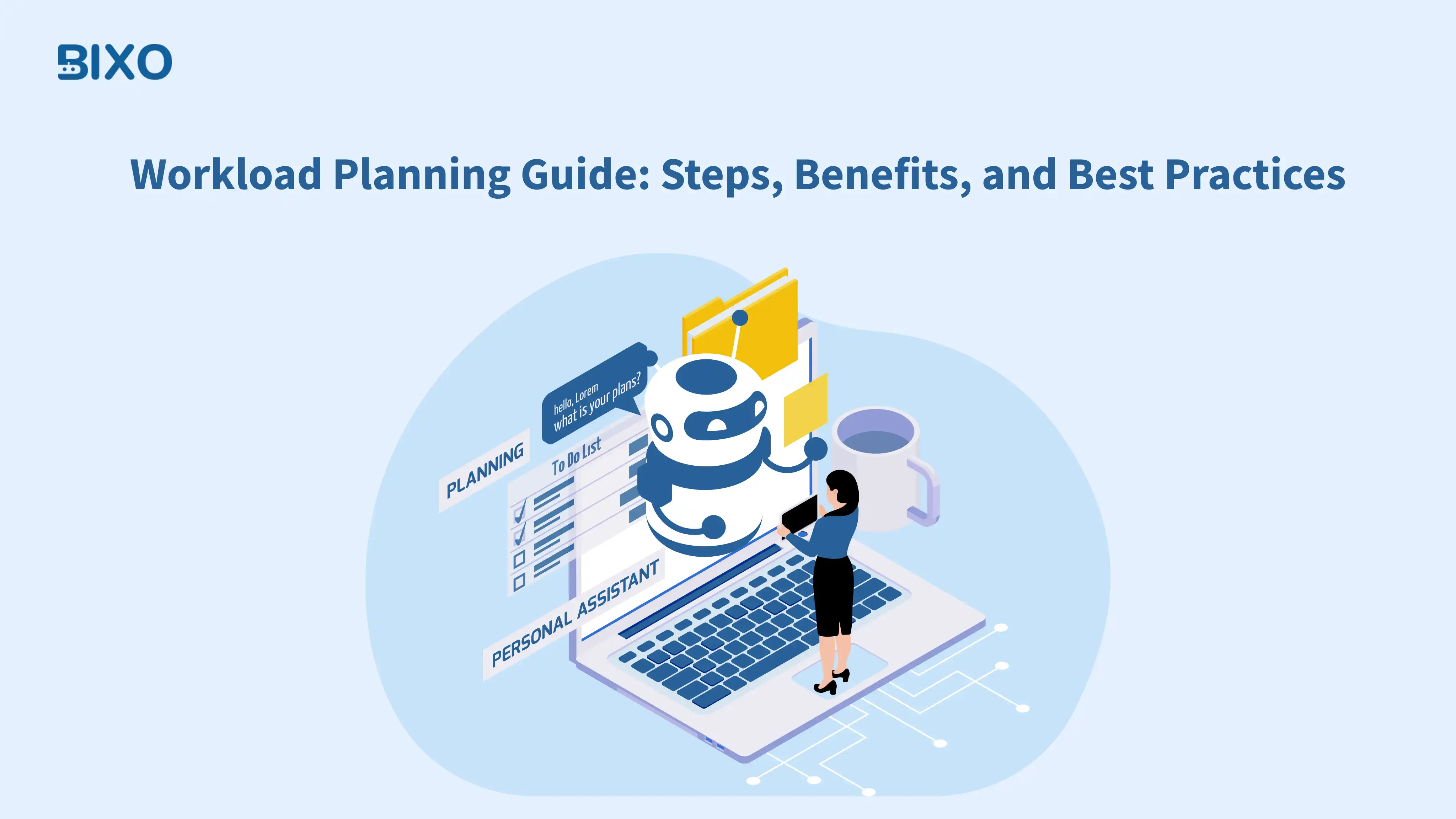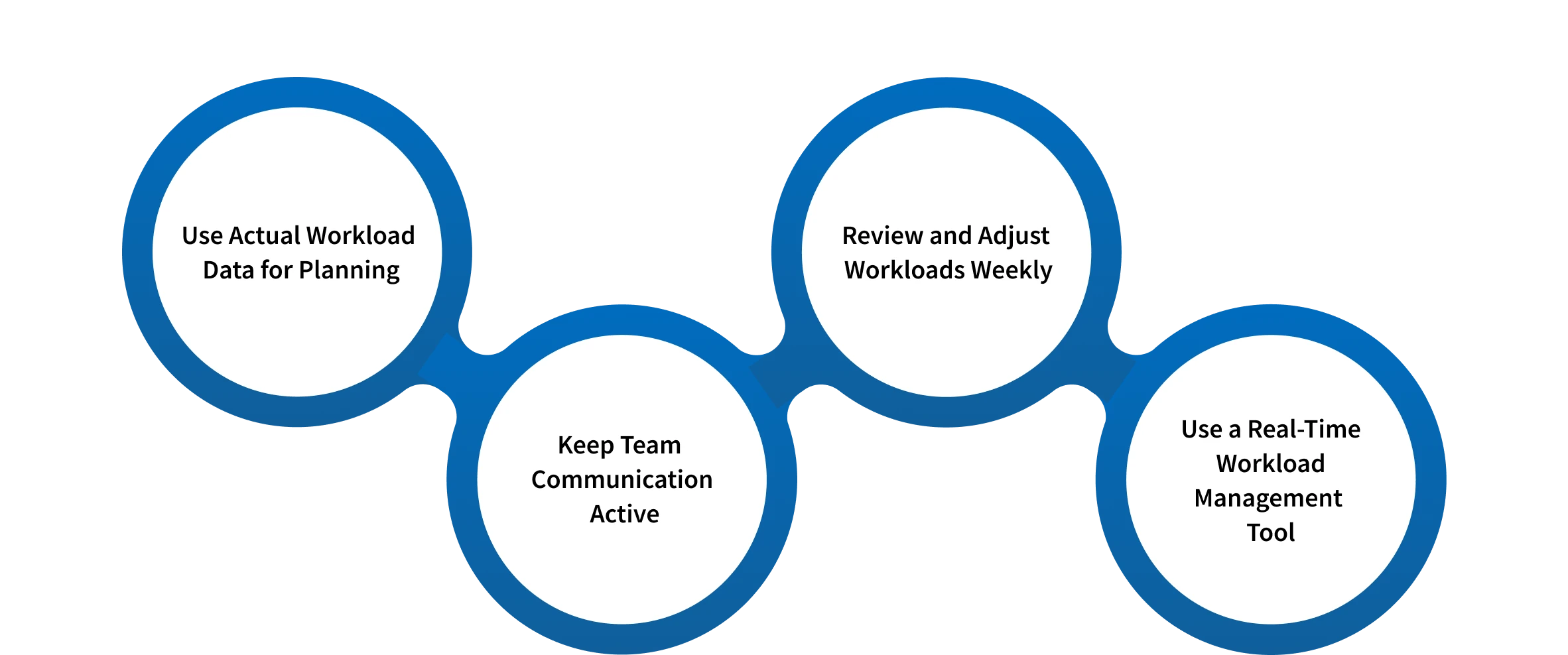
Table of Content
Focus on what matters. BIXO handles the rest!

If you're having trouble dividing work around your team or finding out why deadlines constantly slip, you're not alone. Planning workload effectively enables you to see exactly who's doing what, when, and how much they're actually capable of. It's not simply about keeping people busy, but it's about estimating time, effort, and capacity in a way that works.
With the proper plan and the workload planning tools, you can spot the bottlenecks early, prevent burnout, and keep your team members focused on what is important. This guide shows you how you can plan smarter and manage your workload with confidence.
What Is Workload Planning?
Workload planning involves organising, allocating, and managing tasks across your team members in a way that matches their skills, availability, and capacity. It enables you to see what needs to be done, who's doing what, and whether the workload is balanced. Good workload planning means no one is overworked or underutilised. It's about using your time, people, and resources effectively.
You can leverage workload planning tools or software to get real-time visibility, track progress, and make data-driven decisions. Regardless of whether you're planning a day, a week, or a whole project, workload planning gives you control over how work flows through your team.
How to Plan Workload Effectively in 6 Steps
Here are 6 simple steps to help you plan your workload better. They’ll help you organise tasks clearly, assign them wisely, and keep the work moving smoothly.

Step 1: List and Break Down All Work
Begin by listing everything that has to be done. Don't simply write down large tasks. Divide them into smaller and clearer actions. This makes it easier to see how much work you have to do. When your work is mapped out in detail, you avoid missing pieces and can start your workload planning with clarity.
Step 2: Estimate Time and Effort for Each Item
Once you’ve listed your tasks, determine the time and effort each one will require. Be honest here. Estimating too high or too low will make your project schedule go off track. If you have the previous data, like how long similar tasks took previously, use it. This is where workload planning tools shine. They provide task history that helps you refine your estimates, increasing the accuracy of your workload capacity planning.
Step 3: Assign Work Based on Skills and Availability
TNow it's time to match the right individuals with the right task. Think about who has the skills and who has time. Don't just give all the work to your top performers because they're fast! Spread the workload based on real availability. Workload management tools can help you make each person's schedule clear and prevent accidental overload.
Step 4: Distribute Workload Evenly Across the Team
It is not only about delegation. It is about distributing it evenly. There are individuals who tend to overload themselves. Others may not say anything when they are underutilised. Workload management tools can give you a clear view of how tasks are spread across the team and help you make fast, informed adjustments.
Step 5: Set Realistic Deadlines with Extra Time for Changes
Deadlines can only be effective when they are realistic. Make sure you and your team have enough time to complete tasks properly, and leave a little extra time in case something unexpected comes up. Projects don’t always work out as intended. Things always change, and there are often roadblocks or urgent issues that come up. Leaving this extra time makes your workload planning more flexible and your deadlines more reliable.
Step 6: Monitor Progress and Adjust Workload
When the team begins working, monitor the progress. Are people falling behind? Are priorities shifting? You must be prepared to intervene, rebalance and reassign. This is where real-time workload management tools really help. They show you what is going on in your team in real time, so that you can identify issues early and address them before they become bigger. Effective workload management means being flexible and responsive.
What Are the Key Benefits of Workload Planning?
Workload planning isn’t just about keeping track of tasks. It also helps your team stay focused and work well. Let’s see what benefits it can give you.

Prevents Overload and Burnout
When you use workload planning, you get a clear picture of how tasks are spread across your team. This will enable you to notice when someone is overloaded and prevent them from getting overwhelmed. By balancing the team workload, you can avoid stress and prevent people from burning out. The right workload management tools make it easier to track this in real time, so you can take action before it becomes a problem.
Increases Efficiency and Speed
Workload planning lets you organise tasks based on who’s available and what skills they bring. Work can progress faster as people are not left waiting or trying to balance too many things. Using workload planning software or tools to manage workload helps you assign tasks smartly and keep everything moving smoothly. Efficiency automatically increases when your team has a clear understanding of what to concentrate on.
Strengthens Team Morale and Ownership
When people know what's expected of them and that their time is used meaningfully, they work better. Workload planning establishes a clear role for everyone and avoids unequal workloads, which makes work feel more manageable. When your team notices that the work is planned in a fair way, they will be more likely to take ownership, remain motivated, and trust the process.
Improve Resource Planning
Workload planning doesn’t just help with today’s tasks. It also tells you whether you have enough people or time to deal with what is about to happen. Having a clearer picture of team workload and overall capacity, you will be able to plan future projects more effectively and not have to hire people at the last minute or meet deadlines in a hurry. Whether you use simple methods or advanced workload planning software, the goal is to make smarter decisions with the resources you already have.
What Are the Best Practices for Effective Workload Planning?
Here are some best practices to help you plan work in a clear and easy way.

Use Actual Workload Data for Planning
Guesswork doesn’t work when it comes to workload planning. Unless you have actual data, you are just making wild guesses. It usually results in overload, missed deadlines, or time wastage. Look at previous projects, track the time spent, and utilise that to schedule upcoming work. This makes your workload capacity planning more accurate and helps you set realistic expectations for your team.
Keep Team Communication Active
Workload planning isn’t just about charts and numbers. If your team communicating isn't well, important things will be missed. Keep communication open, especially if priorities change or problems arise. A brief check-in allows you to identify problems in time and redistribute workloads before they become overwhelming.
Review and Adjust Workloads Weekly
No matter how good your project initial plan is, it won’t stay perfect. Priorities shift, new tasks arise, and someone might fall behind. That is why it is important to conduct a weekly review regularly. See what is accomplished, what is behind schedule, and who has too much or too little to do. Regular adjustments keep things balanced and help your workload management stay flexible instead of rigid and stressful.
Use a Real-Time Workload Management Tool
A real-time workload management tool gives you a live picture of who’s doing what, how busy everyone is, and where the pressure points are. They make it easier to reassign tasks quickly, adapt to shifting task priorities, and avoid blind spots. The right workload planning software gives you the ability to act quickly instead of reacting late.
Make Workload Planning Easier With BIXO

Throughout this guide, you have seen that good workload planning depends on dividing tasks, allocating them intelligently, tracking progress, and remaining flexible.
Once you’ve planned the tasks, BIXO handles daily follow-ups. It checks in with your team to see how things are going, keeps track of what’s done or running behind, and only lets you know when you need to step in. You don’t have to chase people for updates or wait for standup meetings to find out what’s going on. It helps you rebalance the workload before it turns into a bigger problem. That means you won’t miss anything important, and you won’t be surprised. You see how the work is going in real time.
BIXO also improves your workload capacity planning. It shows you clearly who’s busy and who has time, so you can avoid overloading or underusing anyone. You can assign tasks based on real availability and move work around without slowing things down.
The result is less time spent on chasing updates, fewer delays, and more time to focus on planning. BIXO helps you handle more people without getting overwhelmed. It’s like having an assistant who makes sure your workload plan runs smoothly every day.
Conclusion
If you want your team to stay focused, hit deadlines, and avoid burnout, workload planning isn’t optional. It’s essential. With the right workload management tools, you have a clear picture of the workload of your team, identify problems early, and make better decisions without second-guessing. Whether you're handling a few tasks or managing complex projects, these tools help you stay in control, adapt quickly, and plan with confidence.
FAQs
Workload planning helps you see who’s doing what, so no one gets too much or too little work. It keeps things organised, helps avoid delays, and makes sure the team runs smoothly.
Good workload planning tools show you what’s happening right now, spot problems early, and help you give tasks to the right people at the right time. This way, you don’t have to keep checking in constantly.
Task assignment means giving people their tasks. Task assignment means clearly choosing and giving each task to the right person. Workload planning is about making sure the work is spread out fairly, deadlines are doable, and no one has too much or too little to do.
Checking your team’s workload once a week is a good idea. It helps you spot any delays, see who’s too busy, and make changes to keep everything on track.
If you use spreadsheets, they don’t update automatically or handle changes easily. Workload management software shows you what’s happening right away and saves you time by doing the tracking for you.





